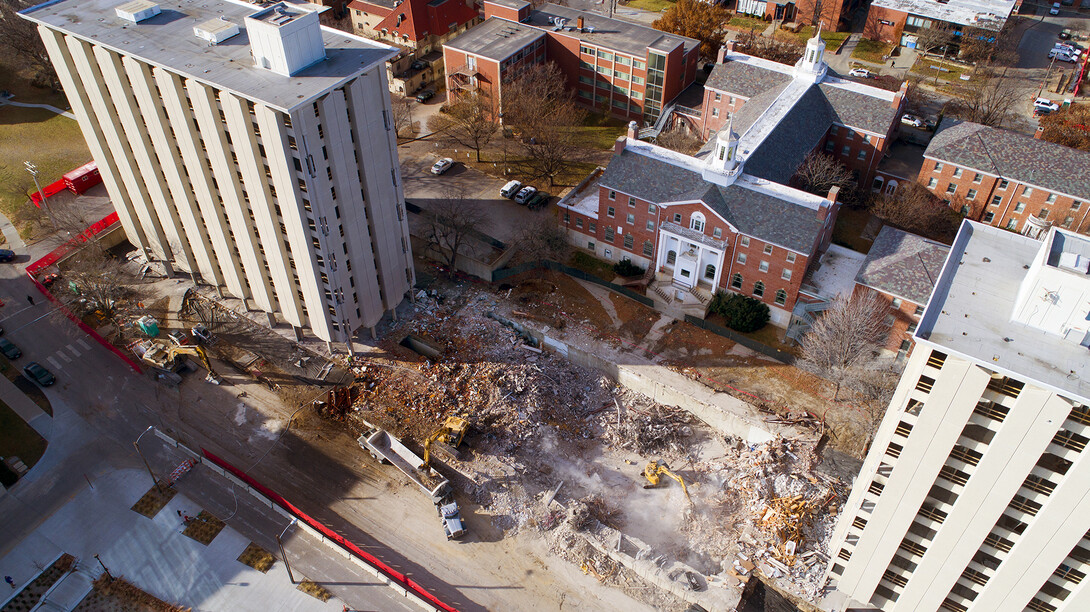
The countdown to the razing of Nebraska’s oldest high-rise residence hall complex is nearing its explosive finale.
At 9 a.m. Dec. 22, the Cather and Pound hall towers are scheduled to be razed via controlled implosion. Faculty, staff, students and the public are being asked to be aware of the event, which will effectively shut down all access to a 16-square-block area around the towers from 6 a.m. to noon.
Here’s what you need to know ahead of the event:
Public viewing area available
A viewing area for media and the public will be available atop the university parking garage at 19th and Vine streets. Parking in the garage — on all floors but the top — will be available.. The Vine Street entrance to the garage will be open until 8 a.m. Access to the garage after 8 a.m. will be available via the southbound lanes of Antelope Valley Parkway. Parking in the garage will be free and open to the public.
Watch live online
If you can’t make it to campus, the university will offer live coverage of the implosion online and through its primary Facebook page. Coverage starts at approximately 8:30 a.m. Video of the implosion will also be available on the Facebook page afterward.
Two perimeters
Between 6 a.m. and noon, two perimeters — an evacuation zone and exclusion zone — will be in place around Cather and Pound halls to protect the public from the razing. A map of the two zones is available at left or online.

Evacuation zone — The interior perimeter (evacuation zone) will encompass about nine square blocks and include buildings nearest to the Cather-Pound site. Only members of the implosion team are allowed in the evacuation zone until the all-clear is sounded. The evacuation zone will be cleared from 5 to 6:15 a.m. Dec. 22. All parking lots within the evacuation zone must be vacated by 10 p.m. Dec. 21.
Exclusion zone — The second perimeter (exclusion zone) will include about 16 square blocks and surround the evacuation zone. It will stretch between Vine and R streets to the north and south, and from Greek houses on the west side of 16th Street to the Beadle Center on the east side of 19th Street. Individuals within the exclusion zone must remain inside buildings from 8 a.m. until the all-clear is sounded.

Roadways to close
Streets through the exclusion zone will close starting at 8 a.m. and should reopen by noon. Those roadways through campus include Vine, R, 16th, 17th and 19th streets. Signage alerting drivers to the closures is scheduled to be in place by Dec. 19. All parking lots within the evacuation zone will be vacated by 10 p.m. Dec. 21.
Final countdown
A siren will be used to communicate time remaining until implosion. Two minutes before detonation, the siren will release two, two-second long signals. A minute prior, a single, two-second signal will be sounded. About four minutes after detonation, members of the implosion team will begin a check of the debris pile and surrounding structures. When the review is complete, a 10-second long signal will indicate the all-clear, which will return campus to normal pedestrian and vehicle traffic access.
Backup date scheduled
If the Dec. 22 implosion must be canceled due to weather or unforeseen conditions, a backup date of Dec. 23 has been planned. The implosion schedule for Dec. 23 will be the same for the original date. Access a complete schedule of the razing process.
Research opportunity
A Nebraska Engineering team has been granted access to the residence hall towers during the demolition process. Data being collected by the faculty-led and student-powered research team will expand understanding of how large structures react to extreme events, and possibly refine engineering models and improve the resilience of buildings. Learn more about the research project.
Who is doing the work
The demolition and cleanup are being completed by Ark Wrecking of Tulsa, Oklahoma. Controlled Demolition of Phoenix, Maryland, is overseeing the handling, placement and ignition of the explosive charges. Watch a video featuring CDI’s work. Prep work on the buildings started in May. The cleanup is scheduled to continue through Nebraska’s spring semester.
Historic towers
The 13-story towers, which opened in 1963, are Nebraska’s first high-rise student housing facility. Each hall offered 20 rooms per floor with two beds in each room. Capacity for the complex was 960 residents. Construction cost for the Cather-Pound complex was $4 million. Financing was provided through revenue bonds and not tax monies. The halls were built to help the university handle enrollment gains in the 1960s. The Cather-Pound food service building, which was between the two towers and removed earlier this fall, included a pair of large dining rooms separated by a kitchen and cafeteria. The dining center, which was designed to feed 1,500 students, was connected by enclosed passageways to both towers and the Neihardt Hall complex to the east. The two towers will fall into the space created by the removal of the dining facility. Learn more about the history of the towers and see photos from when they opened.
Future plans for the space
The Cather-Pound area is designated as a future building site, but the university has no immediate construction plans for the property. It will be converted into a temporary green space.









